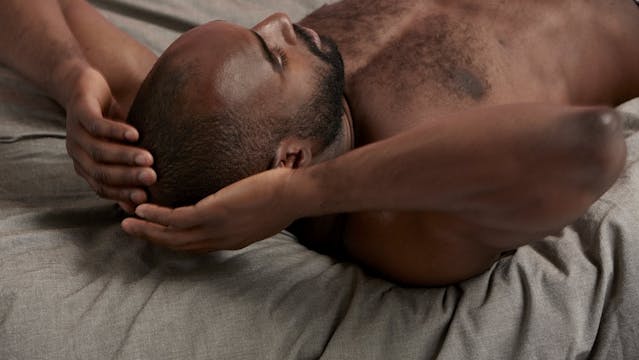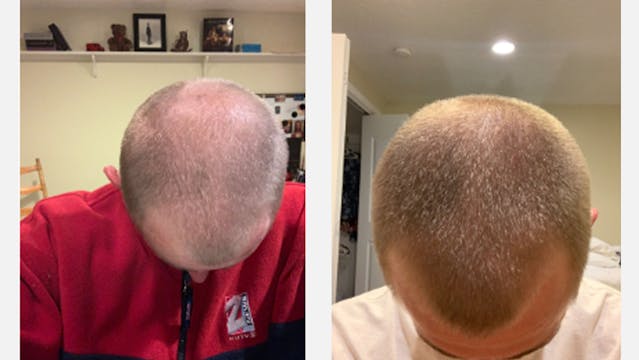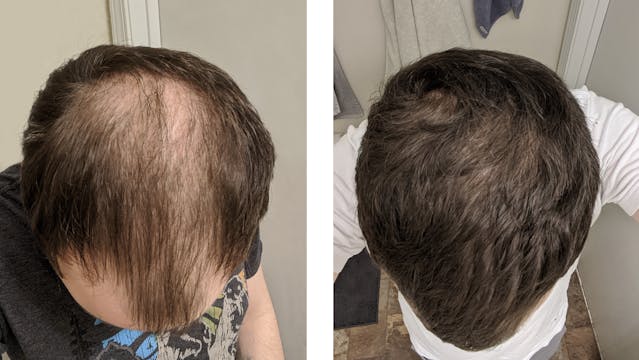For some men experiencing hair loss, finasteride is a miracle treatment. But why doesn’t it work for everyone?
It doesn’t take a thorough search of the internet to find men reporting incredible finasteride results, as they flaunt hair transformations that almost look Photoshopped. When finasteride and minoxidil are combined, you’ll find even more men praising the treatments for their newly transformed mop of hair. But you might have noticed that - while the treatment has proven results - for some men, it simply doesn’t work.
The question is: why?
There are two main reasons why finasteride might not work for you:
- The type of hair loss you have can’t be treated with medication such as finasteride
- You started taking it when too much hair loss had already occurred
We look at what types of hair loss finasteride doesn’t work for and at what point it’s too late to take finasteride, but first, let’s get to grips with how finasteride works...
How does finasteride work?
You’ve probably heard of testosterone but what you might not know about this renowned male hormone is that about 10% of it is converted into another hormone called dihydrotestosterone (DHT). Although this is a completely normal process, when DHT is in the bloodstream, it can signal the hair follicles to shrink, causing hair to become thinner and fall out quicker until eventually, hair growth ceases completely.
DHT doesn’t cause all men to experience hair loss because hair loss is largely driven by our genes. This means that if male pattern baldness runs in the family and you’re genetically predisposed to hair loss, then your hair follicles will have a greater reaction to DHT.
Finasteride works by blocking the conversion of testosterone to DHT. This inhibits the process of follicle-shrinking, allowing hair to become thicker and fuller.
It’s dangerous to take finasteride before hitting puberty as it's an essential hormone for development, but clinical trials have proven it to be a safe and effective treatment for hair loss in adult males over the age of 18-years-old.
Does finasteride grow hair?
As finasteride blocks DHT, the hormone that reduces the size of the hair follicle, it allows the hair to grow thicker and fuller. It can even stimulate growth in areas where the hair is extremely thin or appears fuzzy. However, if the hair follicle is dead and there is absolutely no hair growth then taking finasteride won’t promote new hair regrowth. This is why finasteride isn’t suitable for everyone.
Clinical trials on the daily use of 1mg of finasteride tablets found 83% of men with vertex hair loss (the crown of the head) had no further hair loss after 2 years, with 61% demonstrating mild to moderate hair regrowth, and 5% showing substantial hair regrowth. The treatment also showed promising results - in terms of slowing hair loss and increasing hair growth - on men who were experiencing frontal male pattern hair loss.
The thickening of existing hair can also give the appearance of a much fuller head of hair, even if hair regrowth hasn’t taken place.
Is finasteride suitable for all types of hair loss?
There are several different causes of hair loss. Understanding what type of hair loss you have will help you to pinpoint which treatments are suitable for you.
Types of hair loss that finasteride is suitable for:
- Androgenetic alopecia (male pattern baldness): Male pattern baldness (MPB) is the most common form of hair loss in men, affecting over 50% of men over the age of 50. It’s thought that MPB is triggered by genetics that influence how the hair follicles react to the hormone, DHT. Finasteride prevents the production of DHT making it a perfect fit for men with MPB.
Types of hair loss that finasteride is not suitable for:
- Telogen effluvium (hair loss triggered by stress): Hair loss caused by stress isn’t linked to DHT meaning finasteride isn’t a viable treatment option. If your hair loss has been triggered by a one-off stressful event, you may notice regrowth takes place after a few months. Decreasing stress levels can also help to promote hair regrowth. In terms of treatment, minoxidil stimulates blood flow to the hair follicles which can help with stress-related hair loss.
- Chemotherapy-induced hair loss: If you’ve lost hair due to chemotherapy, you may find it grows back after several weeks of ceasing treatment. The NHS recommends wearing a cold cap while having treatment, to reduce the blood flow around the scalp, which in turn, reduces the amount of chemotherapy medication that reaches the area. Minoxidil is also safe to use if you’ve experienced hair loss due to chemotherapy although results are mixed and further research needs to be done to determine the effectiveness of the treatment on people with hair loss induced by chemotherapy.
- Tinea capitis (fungal infection of the scalp): Most common in children, tinea capitis is an infection of the scalp and should be treated with anti-fungal medication combined with anti-fungal shampoo.
When is it too late to take finasteride?
Even if hair loss has been triggered by male pattern baldness, finasteride isn’t suitable if you have complete hair loss meaning the hair follicles are dead and no longer show any signs of activity. If you have extremely fine hairs or even microscopic stubble, it’s worth trying finasteride.
If you have complete hair loss in some areas of your scalp, for example, the crown or hairline, but slight hair growth in other areas, finasteride could be suitable for you. This is because even if the medication doesn’t stimulate hair regrowth in certain areas of your scalp, it will allow the existing hair to flourish, covering the patches of hair loss and creating a thicker, fuller head of hair.
The numan take
For some men experiencing hair loss, finasteride has miraculous results, especially when combined with minoxidil. However, it’s not suitable for everyone. Finasteride targets the hormone that causes male pattern baldness, meaning that this is the type of hair loss that the medication is most suited to. If you have hair loss caused by stress, chemotherapy or fungal infection, then you’ll need to explore other methods of treatment. If you have complete hair loss then you might not see results taking finasteride, but if you’re showing any sign of hair regrowth then it’s worth trying the treatment.






